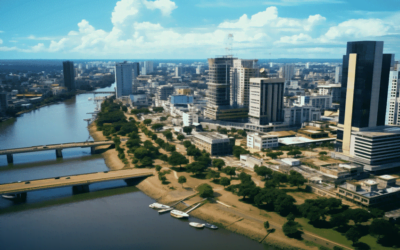Hey there, fellow drone enthusiasts and those looking to explore the skies of Jordan! I understand how daunting it can be to wrap your head around the intricacies of drone regulations in a foreign land, but don’t worry—I’ve got your back.
When I delved into researching the Jordan Drone Laws, I found myself in your shoes, craving a clear guide. After extensive research, I’m excited to share the answers you’ve been seeking.
You know, when I started out on this drone journey, I was a bit overwhelmed by the legalities in Jordan. The complexity of the rules and the sheer volume of information were perplexing, to say the least.
However, my passion for drones drove me to conduct in-depth research on Jordan’s drone laws. I wanted to provide you with a concise, yet comprehensive resource to simplify the intricacies. So, here I am, ready to share my insights, so you can take to the skies with confidence.
Now, if you’re seeking a clear path to navigate Jordan’s drone regulations, you’re in the right place. I’ve crafted this article with the aim of making things crystal clear for you. We’ll delve into the intricacies of drone registration, no-fly zones, altitude restrictions, and much more.
By the time you finish reading, you’ll be well-prepared to explore the Jordanian skies safely and responsibly. So, let’s dive in, and together, we’ll unlock the world of Jordan Drone Laws!
- Drone Regulations in Jordan
- No-Fly Zones and Restricted Areas
- Altitude and Operational Restrictions
- Permissions and Permits
- Privacy, Data Protection, and Ethical Considerations
- Liability Insurance
- Import and Customs Regulations
- Drone Models and Weight Categories
- Final Thoughts On Jordan Drone Laws
- Frequently Asked Questions on Jordan Drone Laws
Drone Regulations in Jordan

Drone enthusiasts take note: Jordan has a set of regulations in place to ensure the safe and responsible operation of drones within its borders.
These regulations are designed to strike a balance between promoting recreational and commercial drone use while safeguarding public safety and national security interests. It’s important to recognize that drone regulations are subject to change, so staying informed about the latest updates is crucial.
Jordan’s drone laws are not set in stone, and updates may occur periodically to address the evolving technology and the country’s security needs.
Therefore, the information provided in this article serves as a foundation, but it’s always wise to consult with local authorities, such as the Civil Aviation Regulatory Commission (CARC) or other relevant agencies, for the most up-to-date rules and requirements.
This ensures that you are well-informed and can enjoy flying your drone in Jordan within the boundaries of the law. So, let’s proceed and explore the various aspects of drone regulations in this fascinating country.
Also Read: Japan Drone Laws
No-Fly Zones and Restricted Areas

When it comes to drone operations, understanding the no-fly zones and restricted areas in Jordan is paramount. Let’s explore the nuances of these critical regulations.
Navigating the No-Fly Zones
Jordan designates several no-fly zones to safeguard its airspace. These areas include airports, military installations, and other sensitive government facilities. Operating a drone in these zones is strictly prohibited. These areas are off-limits for a reason – they are vital for national security and public safety.
The consequences of venturing into these zones without authorization can be severe, including legal repercussions and damage to national security. To ensure your drone flights are within the bounds of the law, it’s essential to familiarize yourself with the specific no-fly zones in Jordan.
Consequences of Unauthorized Flights
The repercussions of flying a drone in restricted areas extend beyond legal issues. Unauthorized drone flights can pose significant risks to aviation safety and national security.
Airports, in particular, are high-risk zones where drone interference can lead to accidents or flight delays.
In military installations and sensitive government facilities, drones can be perceived as security threats, potentially leading to serious consequences for the operator.
It’s crucial to remember that drone operations should always prioritize safety and respect for security considerations.
Consultation and Compliance
To ensure you stay well within the bounds of Jordan’s drone regulations, it’s vital to consult aeronautical charts and local authorities.
These resources can provide up-to-date information on restricted areas and the specific rules that govern them.
By staying informed and obtaining the necessary permissions for authorized flights, you can navigate the skies of Jordan safely and responsibly.
Consulting local authorities not only helps you avoid legal issues but also fosters a culture of responsible drone operation that contributes to the well-being of all.
Also Read: Jamaica Drone Laws
Altitude and Operational Restrictions

Now, let’s explore the rules that dictate the altitude and operational restrictions for drones in Jordan.
Scaling Heights: Maximum Altitude Limits
In Jordan, drone operators are generally restricted to a maximum altitude of approximately 300 feet (about 91 meters) above ground level.
Adhering to these altitude limits is crucial, as it ensures the safe coexistence of drones with other airspace users, such as manned aircraft.
Straying above the prescribed altitude can not only violate regulations but also create potential safety hazards.
Therefore, whether you’re capturing breathtaking aerial footage or embarking on a recreational flight, be mindful of these height constraints to ensure a safe and compliant experience.
Stay Grounded Around Crowds and Urban Areas
Flying drones near public events, crowded areas, and urban locations entails its own set of restrictions.
The Jordanian authorities have taken measures to ensure the safety and privacy of the public. Flying over gatherings or urban spaces must be done with great caution.
Unauthorized drone flights in these settings can result in breaches of privacy, safety concerns, and potential legal ramifications.
It’s important to respect these operational boundaries and seek appropriate permissions when required, allowing for a harmonious coexistence of drones and public events.
Navigating the Skies Responsibly
Maintaining a visual line of sight with your drone during flight is a fundamental rule in Jordan. This means that you should always be able to see your drone without the aid of binoculars or other visual devices.
The rule is in place to ensure that operators have full control over their drones and can respond to changing conditions swiftly.
Furthermore, night operations may be subject to specific regulations. Flying a drone at night often requires proper lighting to make the aircraft visible and to comply with safety guidelines. These rules ensure that drone operations, even in low-light conditions, are conducted safely and responsibly.
By respecting these altitude and operational restrictions, you can enjoy the world of drone flight in Jordan while safeguarding the safety and privacy of others. Now, let’s move on to the next set of guidelines.
Also Read: Italy Drone Laws
Permissions and Permits

In the realm of drone operations, understanding the processes for obtaining permissions and permits is key to exploring unique circumstances and special operations in Jordan.
Navigating Special Operations: Obtaining Permissions
Special drone operations may arise for various purposes, be it for research, commercial projects, or other unique circumstances. In such cases, obtaining the necessary permissions is crucial. The process typically involves reaching out to the relevant authorities in Jordan.
This can be the Civil Aviation Regulatory Commission (CARC) or other local agencies responsible for regulating drone operations. These permissions ensure that your drone flights align with the specific objectives you have in mind and adhere to safety and privacy considerations.
The Application Process and Document Requirements
When seeking permissions or permits for drone operations in Jordan, the application process should not be daunting. It usually involves submitting a formal request that outlines the nature of your operation, its purpose, and the locations involved.
Additionally, you may be required to provide documents such as flight plans, risk assessments, and proof of liability insurance. These requirements can vary based on the nature of your operation and should be outlined by the relevant authorities.
Ensuring you have all the necessary documents in order will help streamline the application process.
Emphasizing Compliance and Responsibility
It’s essential to understand that permits come with specific conditions that must be adhered to. These conditions are put in place to ensure that your drone operations align with safety and privacy regulations in Jordan.
Ignoring or neglecting these conditions can lead to violations and potential consequences. Therefore, compliance is not just a legal requirement but also a mark of responsible drone operation.
Whether it’s respecting no-fly zones, flying at a specific altitude, or adhering to operational boundaries, complying with the conditions outlined in your permit is of utmost importance.
By familiarizing yourself with the process of obtaining permissions and permits in Jordan and emphasizing compliance, you can embark on specialized drone operations with confidence and integrity. Now, let’s proceed to the next section of our drone journey in Jordan.
Also Read: Israel Drone Laws
Privacy, Data Protection, and Ethical Considerations

As we soar into the skies with our drones, we must also be mindful of privacy, data protection, and ethical considerations that are crucial in the Jordanian drone landscape.
Safeguarding Privacy: Jordan’s Drone Privacy Laws
Respect for privacy is a cornerstone of responsible drone operation. In Jordan, privacy laws concerning drone operations are in place to protect individuals from unwanted intrusions. These laws dictate that capturing images or videos with drones should not infringe upon an individual’s right to privacy.
It’s essential to recognize that flying over private properties or capturing images of individuals without their consent can be a violation of these laws. As responsible operators, it’s our duty to adhere to these regulations and safeguard the privacy of others.
Guidelines for Responsible Imaging
Operating a drone equipped with a camera is a powerful tool for capturing stunning visuals, but it’s essential to follow guidelines that respect the privacy of individuals.
When flying your drone, be cautious about capturing images or videos of people in private settings without their explicit consent.
Avoid hovering over residential areas or sensitive locations where privacy concerns are more pronounced. By adhering to these guidelines, you not only stay compliant with the law but also foster a culture of responsible and ethical drone operation.
Ethical Responsibility in the Skies
Operating a drone isn’t just about knowing the laws and regulations; it’s also about upholding a strong ethical code. Emphasizing responsible drone use is a shared responsibility among all operators. This means considering the implications of your actions on the environment, wildlife, and the people you encounter during your flights.
Whether it’s minimizing noise pollution, avoiding sensitive habitats, or respecting the privacy of others, these ethical considerations make us better stewards of the skies. Let’s aim for a drone community in Jordan that sets an example of responsible and ethical operation for the world to follow.
By understanding privacy laws, following ethical guidelines, and embracing responsible drone use, we can explore Jordan’s beautiful landscapes and vibrant cities while respecting the privacy and rights of others. Now, let’s continue our journey through the intricacies of Jordan’s drone regulations.
Also Read: Ireland Drone Law
Liability Insurance

Liability insurance is a crucial aspect of responsible drone operation, and understanding its significance is vital for drone enthusiasts in Jordan.
Safeguarding Against the Unexpected: The Importance of Liability Insurance
Having liability insurance as a drone operator is not just a choice but a necessity. It serves as a safety net in the event of accidents, damage, or unforeseen incidents during drone flights. While no one intends for mishaps to occur, they can happen to even the most skilled operators.
Liability insurance offers protection against potential legal liabilities, property damage, or bodily harm that may result from drone operations. By being covered, operators demonstrate their commitment to responsible flying and ensure that they are financially prepared for any unexpected situations.
Navigating the Insurance Landscape
In Jordan, as in many other countries, there are insurance requirements and coverage options tailored to drone operators. The specific requirements may vary based on the nature of the operation and the drone’s weight.
It’s essential to be well-informed about these requirements and select an insurance policy that best aligns with your needs.
Policies typically cover aspects such as third-party liability, property damage, and even theft or loss of your drone equipment. By exploring the available coverage options, you can make a well-informed decision and operate your drone with peace of mind.
Consequences of Flying Uninsured
Operating drones without proper liability insurance coverage can lead to various consequences. In the event of an accident, operators who lack insurance may be held personally responsible for property damage or bodily harm. Legal repercussions and financial burdens can be overwhelming.
Additionally, insurance may be a requirement for obtaining permits for certain drone operations. Therefore, flying without insurance not only exposes operators to significant financial risks but also limits their opportunities for specialized drone missions.
To ensure a responsible and compliant drone operation in Jordan, having the right insurance coverage is indispensable.
By recognizing the importance of liability insurance, exploring available coverage options, and understanding the consequences of flying uninsured, drone enthusiasts in Jordan can fly with confidence, knowing that they are prepared for any unforeseen circumstances. Let’s continue our journey through Jordan’s drone regulations.
Import and Customs Regulations

As drone technology crosses international borders, it’s essential to be well-versed in the customs and import regulations that govern bringing unmanned aerial vehicles into Jordan.
Also Read: Iraq Drone Laws
Navigating the Entry Point: Customs Regulations for Drones
When it comes to importing drones into Jordan, you’ll encounter specific customs regulations designed to ensure the lawful entry of unmanned aerial vehicles. These regulations help control the inflow of drone technology and can encompass aspects such as import duties, documentation requirements, and safety checks.
Complying with these regulations is essential to avoid any legal issues and ensure the smooth passage of your drone through customs.
Documentation and Procedures for Seamless Entry
To bring unmanned aerial vehicles into Jordan, you’ll need to follow specific documentation and procedures. These may include providing a detailed inventory of your drone equipment, stating the purpose of import, and adhering to any import licensing requirements.
Customs authorities will review your documentation to assess the drone’s compliance with safety and legal standards. It’s important to be thorough in preparing the necessary paperwork to prevent any delays or complications during the import process.
Legal Compliance for Uninterrupted Exploration
Understanding and complying with import regulations is not just about navigating the entry process; it’s also about ensuring that your drone operations in Jordan are legally sound.
Failure to comply with import regulations can lead to legal issues, including delays in clearing customs, penalties, or even confiscation of your equipment.
By diligently adhering to these regulations, you not only prevent legal complications but also demonstrate a commitment to responsible and lawful drone operations.
By delving into the customs regulations for importing drones into Jordan, mastering the documentation and procedures, and recognizing the importance of compliance, you can seamlessly introduce your unmanned aerial vehicle to the Jordanian skies, paving the way for safe and responsible exploration.
Now, let’s continue our journey through Jordan’s drone laws.
Also Read: Iran Drone Law
Drone Models and Weight Categories

Drone models and their weight categories play a significant role in the world of drone regulations. Let’s explore how these factors affect the rules governing drone operations in Jordan.
Diverse Regulation for Drone Models
Drone regulations in Jordan often differentiate between various drone models and their weight categories. The categorization is typically based on the weight of the drone, and it’s crucial to understand that different rules apply to different categories.
This differentiation aims to ensure that the regulatory framework aligns with the potential risks and capabilities associated with drones of varying sizes and specifications. As drone enthusiasts, recognizing this distinction is key to responsible and compliant operations.
Navigating the Size and Weight Constraints
Drones come in an array of sizes and weight classes, from compact and lightweight models to larger, more robust ones. The rules specific to each category can encompass aspects such as altitude limits, operational boundaries, and permissions.
Smaller drones may have fewer restrictions, while larger and heavier models might require more comprehensive permits and adherence to stringent regulations. By familiarizing yourself with the rules that apply to your specific drone category, you ensure that your operations remain within the bounds of the law.
Tailoring Compliance to Your Drone’s Characteristics
Understanding the characteristics of your drone is not just about knowing its capabilities; it’s about adapting your compliance to the regulations specific to its size and weight. Complying with the right set of rules ensures that your operations are safe, responsible, and legal.
It’s essential to recognize that failing to adjust your approach based on your drone’s characteristics can lead to violations and potential legal consequences. By staying informed and aligning your operations with the regulations tailored to your drone’s category, you can explore the Jordanian skies with confidence.
By appreciating how drone models and weight categories are regulated differently, adapting your approach based on your specific drone, and ensuring compliance, you can navigate the diverse landscape of drone regulations in Jordan effectively. Let’s continue our exploration of Jordan’s drone laws.
Also Read: Indonesia Drone Law
Final Thoughts On Jordan Drone Laws

As our journey through the intricate web of Jordan’s drone laws and regulations comes to an end, it’s time for some final reflections on what we’ve uncovered.
Jordan’s drone laws are a crucial foundation for all drone enthusiasts and operators. They not only provide a framework for safe and responsible operation but also safeguard the privacy, security, and well-being of the public.
By understanding these laws and adhering to them, we can explore the stunning landscapes, capture breathtaking visuals, and contribute to the drone community in Jordan.
One thing we’ve learned during this journey is that drone regulations are not set in stone. They evolve to keep pace with advancing technology and the changing needs of society.
Therefore, staying updated with the latest regulations is vital. Jordan’s Civil Aviation Regulatory Commission (CARC) and other relevant authorities are valuable sources for current information. By making a habit of staying informed, you ensure that your drone operations remain compliant and safe.
To my fellow drone enthusiasts, I encourage you to embrace the responsibility that comes with the thrill of drone operation. Drones are incredible tools for exploration and creativity, but their impact on society and the environment is equally significant.
Embrace the ethical code of responsible drone operation. Prioritize safety, respect privacy, and fly with integrity. By doing so, you contribute to a thriving drone community that sets an example for safe, responsible, and enjoyable drone flights.
With these final thoughts, I hope you embark on your drone journeys in Jordan and beyond, equipped with the knowledge and responsibility that ensure a harmonious coexistence of drones and society. Fly high, explore, and make the most of this captivating world of aviation.
Frequently Asked Questions on Jordan Drone Laws
1. Are Jordan’s drone laws subject to change?
Absolutely, Jordan’s drone regulations are subject to change, and it’s important to stay updated with the latest rules and requirements. The country’s authorities periodically review and update these laws to align with evolving technology and national security needs. Always consult with local authorities for the most current information to ensure your operations are compliant.
2. Can I fly my drone at night in Jordan?
Night operations with drones are allowed in Jordan, but they often come with specific regulations. To fly at night, your drone typically needs to have proper lighting to make it visible, ensuring safety and compliance. It’s crucial to be aware of these guidelines and follow them to operate your drone responsibly after dark.
3. What are the consequences of flying drones in restricted areas in Jordan?
Operating drones in restricted areas, such as airports and military installations, can have serious consequences. This includes potential legal repercussions and damage to national security. Drone operators should avoid these areas at all costs. Always consult aeronautical charts and local authorities to identify and steer clear of restricted zones.
4. Is liability insurance required for drone operations in Jordan?
While liability insurance is not always mandatory for all drone operations in Jordan, it is highly recommended. Having liability insurance is crucial for safeguarding against unforeseen accidents, legal liabilities, property damage, and bodily harm that may result from drone flights. It demonstrates responsible flying and prepares you for unexpected situations.
5. How are drones of different sizes and weight categories regulated in Jordan?
Drone regulations in Jordan differentiate between various drone models and their weight categories. The rules vary based on the drone’s size and weight. Smaller drones may have fewer restrictions, while larger models require more comprehensive permits and adherence to stringent regulations. It’s vital for drone operators to understand the rules specific to their drone’s category to ensure compliance and responsible operation.













